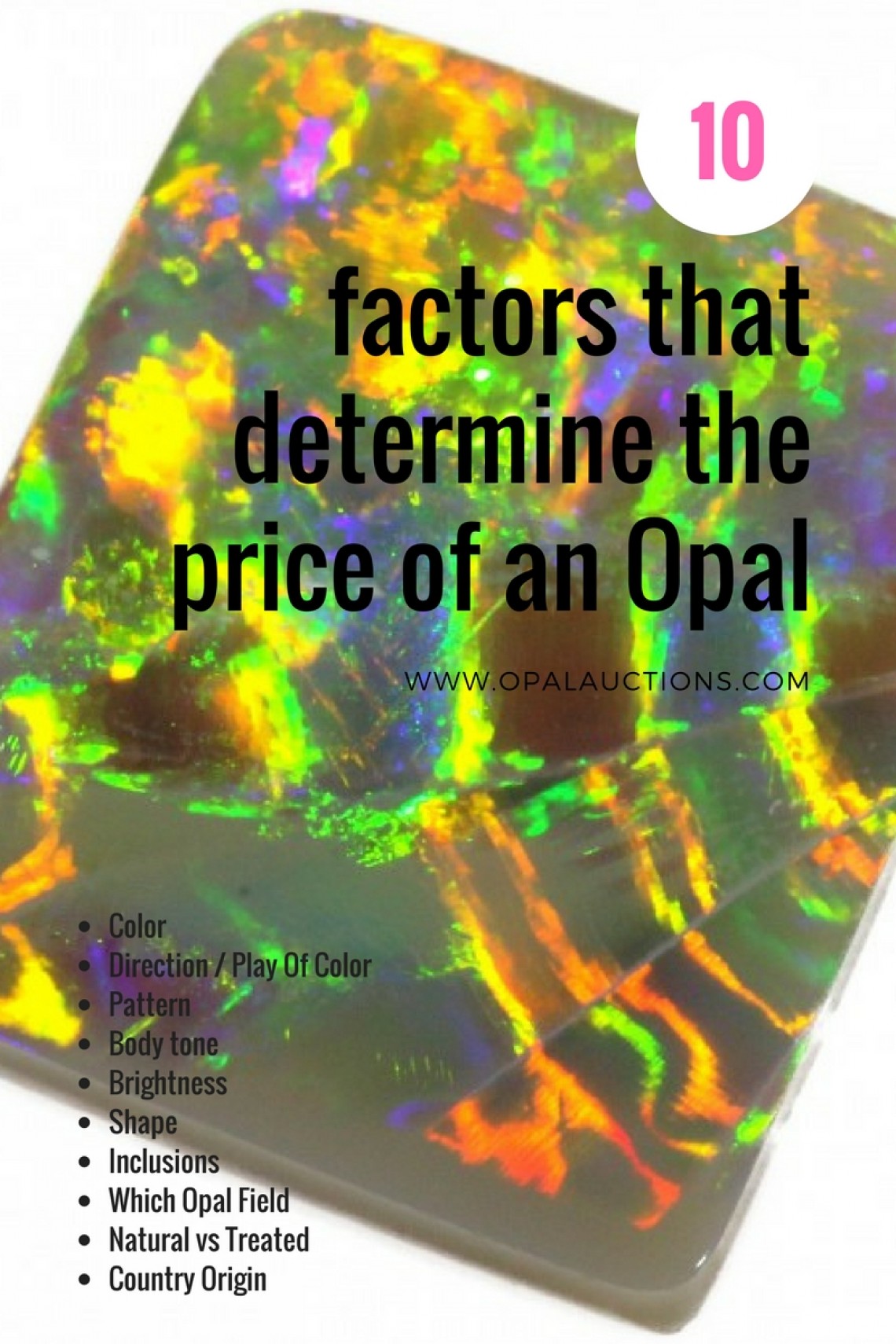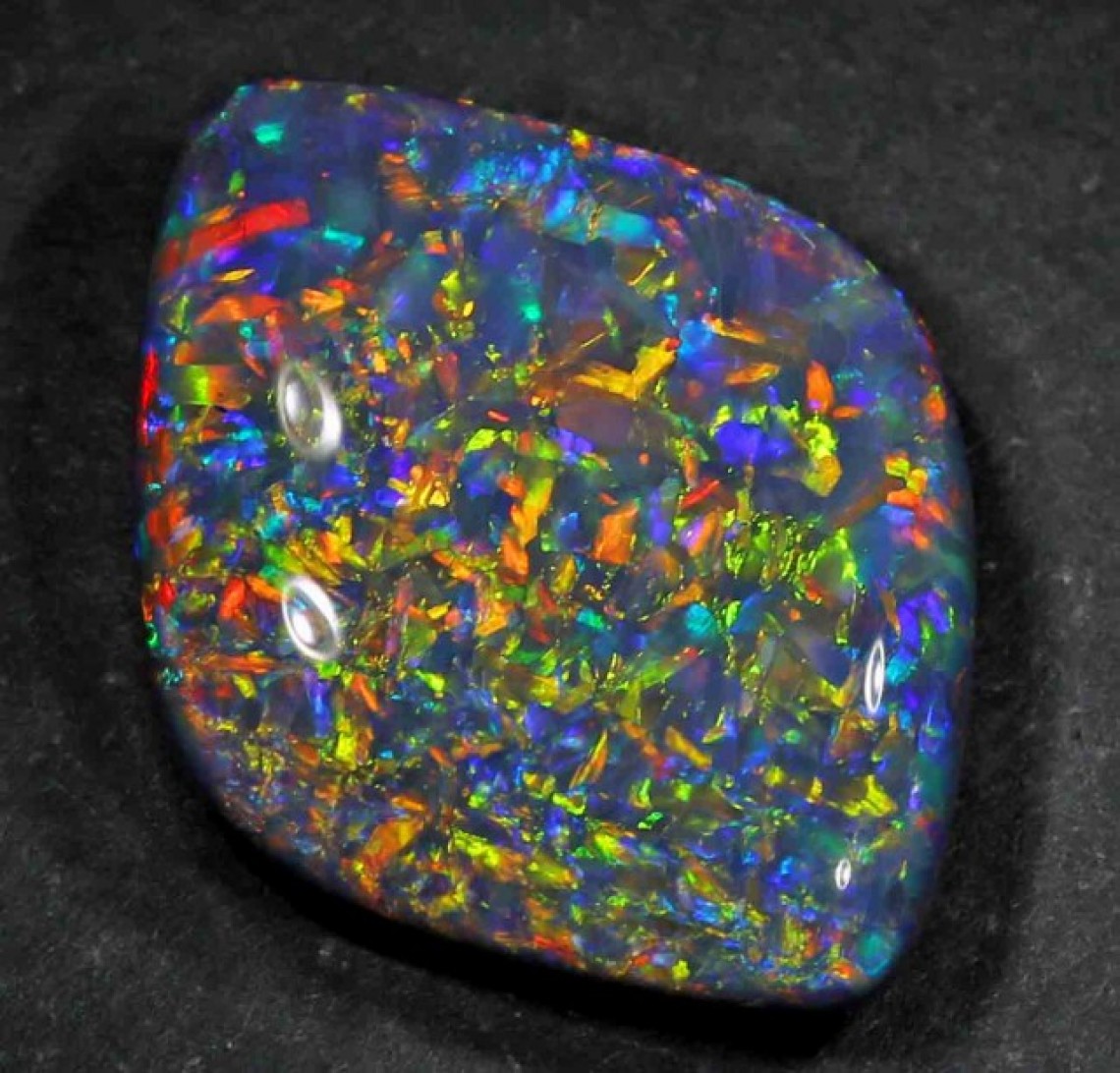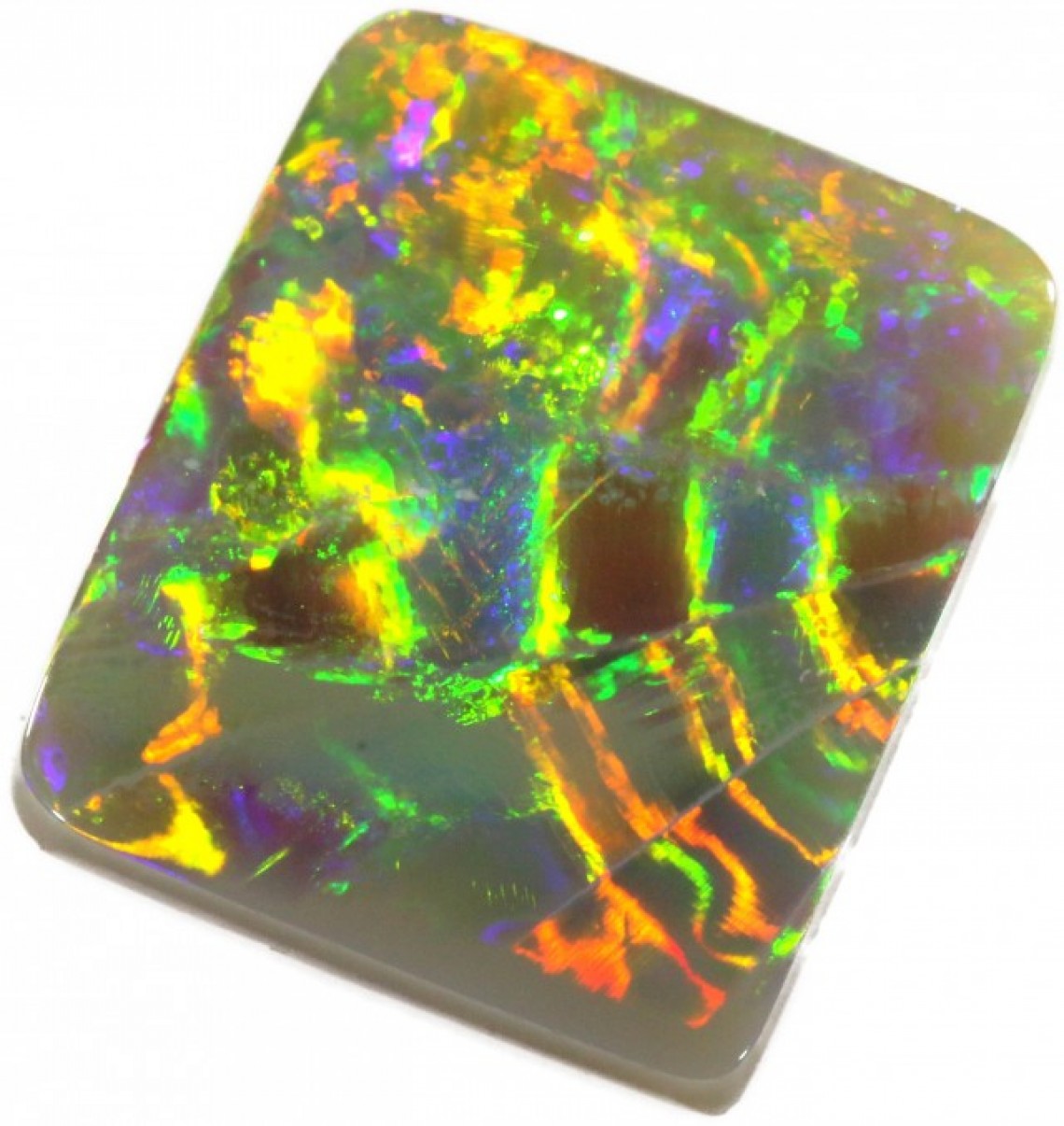
Veröffentlicht am 15th Oct 2020
Geändert am 25th Feb 2024
So bewerten Sie Opale – die 10 Faktoren
 Auf einer Skala von eins bis zehn ist der Opal der Edelstein, der am schwierigsten zu bewerten ist. Opale weisen eine unendliche Anzahl von Variablen auf, darunter Farbe, Muster, Helligkeit und Herkunft. Opale haben ein kompliziertes Klassifizierungssystem für die Bewertung, das viel schwieriger ist als bei Diamanten oder anderen Edelsteinen.
Auf einer Skala von eins bis zehn ist der Opal der Edelstein, der am schwierigsten zu bewerten ist. Opale weisen eine unendliche Anzahl von Variablen auf, darunter Farbe, Muster, Helligkeit und Herkunft. Opale haben ein kompliziertes Klassifizierungssystem für die Bewertung, das viel schwieriger ist als bei Diamanten oder anderen Edelsteinen.
Wenn Sie bereit sind, den Schritt zu wagen und Ihren ersten Opal zu kaufen, oder wenn Sie ein begeisterter Sammler sind, führt Sie dieser Artikel durch die 10 Faktoren, die den Endpreis eines Opals beeinflussen.
Da es 10 verschiedene Faktoren gibt, die den Endpreis eines Opals beeinflussen, gibt es eine gewisse Preisschwankung. Viele Opalbergleute können ihre Opale unter- oder überbewerten, wenn es um Angebot und Nachfrage und den Markt geht, auf dem sie verkaufen. Viele Käufer bei Opalauktionen verwenden unsere ITEM WATCH , um zu verfolgen, zu welchem Preis Opale verkauft werden.
Im Laufe der Jahre wurden Richtlinien zur Bewertung von Opalen entwickelt. Wir werden die 10 Faktoren untersuchen, die zum endgültigen Wert eines Opals beitragen. Diese Faktoren sind:
- Farbe
- Regie / Farbenspiel
- Muster
- Körpertonus
- Helligkeit
- Form
- Einschlüsse
- Welches Opalfeld
- Natürlich vs. behandelt
- Herkunftsland
Wie Opal in Lightning Ridge, Australien, bewertet wird
In Lightning Ridge in Australien gibt es ein Komitee, das jeden Samstag die Opale der Opalbergleute bewertet. Mehrere erfahrene Opalschätzer werden den Preis des Opals pro Karat ermitteln und der endgültige Wert wird anhand des Durchschnittspreises pro Karat bestimmt. Die oben genannten Faktoren können von Person zu Person unterschiedlich sein, und das ist der Grund, warum es bei den Bergleuten Unterschiede beim Preis pro Karat geben kann.
Wenn Ihnen in diesem Artikel einige Begriffe nicht klar sind, finden Sie in unserem Glossar Erklärungen zu praktisch allen Begriffen aus der Opal-Welt.
FARBE
Die Farbe ist das Erste, was Ihnen an einem Opal auffällt. Rot ist die seltenste und begehrteste Farbe. In der Reihenfolge ihres Wertes ist Rot die wertvollste Farbe, gefolgt von Orange, Grün, Blau und Violett. Opale haben jedoch normalerweise nie eine einzige Farbe. Es ist wichtig zu entscheiden, welche Farbe die dominierende Farbe ist und welche Sekundärfarben folgen. Verwenden Sie die dominierende Farbe als die Farbe, die den Preis beeinflusst.
Besonders erwähnenswert sind beispielsweise rote Opale mit einem darin versteckten violetten Farbstreifen. Dadurch entsteht eine tiefe, majestätische rote Farbe. Auch elektrisch blaue Opale sind wertvoller, da der versteckte Farbstreifen den Opal heller macht als das normale Blau.
Dichte und Intensität der Farbe sind ebenfalls wichtig für die Preisbestimmung. Die Dicke des Farbstreifens kann dazu beitragen, die Brillanz der Opalfarbe zu verstärken. Nahtopale haben im Allgemeinen einen dünneren Farbstreifen als Opale, die in einer Knubbelform geformt sind.

Farbrichtung
Opale sind Edelsteine, deren Aussehen sich je nach Betrachtungswinkel dramatisch ändert. Wenn ein Opal am hellsten ist, nennt man das „Facetten“. Die Farbrichtung kann sich auf den Preis auswirken, da sie bestimmt, wie vielseitig der Opal ist. Wenn er nur in eine Richtung strahlt, ist er zum Beispiel möglicherweise nur für einen Anhänger geeignet.
- Opale, die aus allen Richtungen starkem Feuer ausgesetzt sind, eignen sich gut als Ringsteine. Diese Opale sind sehr vielseitig und wertvoller als einseitig ausgerichtete Opale. Ein Opal von guter Qualität sieht aus jeder Richtung gut aus.
- Ein Opal, der in eine Richtung zeigt, eignet sich ideal für einen Anhänger. Der Juwelier wird ihn in die richtige Richtung setzen, damit möglichst viel Feuer sichtbar ist.
- Einige mehrfarbige Opale können eine oder zwei kräftige Farben mit unterschiedlichen Richtungsflächen aufweisen, was für den Juwelier schwierig sein kann, diese einzufassen.
- Tote Stellen entstehen, wenn aus einem bestimmten Winkel keine Farbe sichtbar ist. Diese mindern den Gesamtwert des Opals.
MUSTER
Opale mit einem seltenen oder einzigartigen Muster sind wertvoller. Das Harlekin-Muster ist das seltenste und beliebteste Muster bei Opalen, aber es ist sehr selten. Ein echtes Harlekin-Muster ist ein breites Mosaikmuster mit einer eckigen, dichten Farbpalette. Blumenmuster werden manchmal als florales Harlekin-Muster bezeichnet.
Einige der beliebtesten Muster sind Makrele, Block, Breitblitz, Rollblitz, Pinfire, Regenbogen und der begehrteste äthiopische Opal ist das Wabenmuster. Opale ohne oder mit nur einem leichten Muster sind im Allgemeinen weniger wertvoll.

KÖRPERTONUS
Der Opal Body Tone Guide wurde von der Opal Association of Australia herausgegeben und sollte als Leitfaden für Schwarzopale und Boulder-Opale dienen. Heute wird er allgemein für alle Opale weltweit akzeptiert. Opale werden in 9 Unterkategorien von N1 bis N9 eingeteilt, wobei N1 der dunkelste Opal und N9 der hellste ist.
- Schwarze Opale sind im Allgemeinen die wertvollsten und haben einen Körperton von N1 bis N4
- Opale mit N5 bis N6 gelten als halbschwarze oder dunkle Opale.
- Die Körpertöne N7 bis N9 werden als Kristallopale bezeichnet.

HELLIGKEIT
Der Opal-Helligkeitsleitfaden wurde von der australischen Opalvereinigung zusammen mit dem Körpertonleitfaden erstellt. Es gibt 7 Unterhelligkeitsbewertungen, wobei B1 die hellste bis B7 die trübste ist. Je heller der Opal, desto teurer ist sein Wert. 
FORM
Ovale Steine werden im Allgemeinen als wertvoller angesehen als frei geformte, außer bei Boulder-Opalen, bei denen die freie Form als wünschenswert gilt. Die Form des Opals bestimmt wiederum, wie vielseitig er ist. Ovale Steine haben im Allgemeinen die beste Farbfläche und können für eine Vielzahl von Anwendungen verwendet werden.
Opale werden fast immer als Cabochon geschliffen. Ein Cabochonstein ist wertvoller, wenn er eine hohe Kuppel hat, als ein flacher Stein. Das liegt daran, dass Cabochons ideale Steine für Ringe sind, flache Steine jedoch weniger begehrt sind, da sie für viele Schmuckdesigns nicht verwendet werden können.
INKLUSIVE
Einschlüsse und Risslinien dürfen nicht mit Rissen verwechselt werden. Eine Risslinie reflektiert Licht und mindert den Wert eines Opals erheblich. Es lohnt sich, über den Unterschied zwischen Haarrissen und Rissen in einem Opal zu lesen.
Eine Potch-Linie weist keine Lichtreflexion auf und diese Opale werden im Allgemeinen weniger geschätzt, können aber künstlerische Bildmuster erzeugen.
Einige Opale weisen aufgrund der Einschlüsse ein Vegetationsmuster auf. Dies ist beliebt, da der Opal einen Teil des Baumes oder der Vegetation ersetzt hat. Sand oder Fenster mindern ebenfalls den Wert des Opals. Ein Fenster ist eine Lücke am Boden, wo sich kein Potch gebildet hat und der Opal transparent ist.
Äthiopischer Opal kann Geister- oder Phantomeinschlüsse oder Pflanzenstoffe aufweisen. Diese Arten von Einschlüssen werden bei dieser Art von Opal allgemein als angemessen angesehen. 
OPALFELDQUELLE
Der Endkäufer oder Großhändler kann diesen Faktor möglicherweise nicht berücksichtigen. Aber in der Branche haben bestimmte Minen den Ruf, Rohsteine guter Qualität zu produzieren, aus denen sich hervorragende Steine herstellen lassen. Dies ist in australischen und äthiopischen Opalfeldern der Fall. Sogar die Tiefe der Mine kann den Wert erheblich beeinflussen.
Im Handel kann dies ein wichtiger Faktor für Wiederholungskäufer sein. Wenn Sie feststellen, dass ein Verkäufer bestimmte Aktien hat, die Ihnen gefallen, kaufen Sie am besten aus dieser Gruppe.
NATÜRLICH ODER BEHANDELT
Natürlicher Opal wird immer höher bewertet als behandelter Opal. In den letzten Jahren wurde geräucherter oder behandelter äthiopischer Kristallopal als natürlicher schwarzer Opal verkauft. Diese Behandlung ist nicht dauerhaft. Opal Auctions hat Verkäufer, die deutlich angeben müssen, dass der Opal behandelt wurde. Leider werden mittlerweile viele gefälschte Opale zum Verkauf angeboten, nicht nur online, sondern auch in Paketen mit Rohopalen.
Auch vor gefälschtem oder synthetischem Opal muss man auf der Hut sein. Informieren Sie sich am besten darüber , wie Sie einen gefälschten Opal erkennen.
Opal-Dubletten und -Tripletts unterliegen nicht den gleichen strengen Kriterien wie massive Opale und werden erheblich weniger geschätzt. Es ist wichtig, einen Doublet-Opal von einem massiven unterscheiden zu können, und dies kann schwierig sein, wenn der Opal in Schmuck eingefasst ist. Sehen Sie sich diese Ressourcen an:
URSPRUNGSLAND
Australien hat weltweit den Ruf, die teuersten Opale der Welt zu haben. Viele Länder produzieren inzwischen gute Opale, wie Äthiopien, Mexiko und Brasilien. Die Opale jedes Landes können einzigartig sein und dieser Faktor bestimmt den Opalpreis.
OPALE KAUFEN
Suche nach Opal Encyclopedia
Verwandte Auktionen
In Verbindung stehende Artikel
New South Wales produziert die wertvollste Menge australischer Opale. Die beiden berühmtesten Gebiete sind Lightning Ridge, bekannt für die Produktion von schwarzem Opal, der wertvollsten Form, und White Cliff.
16th Oct 2018
Südaustralien hat eine reiche Geschichte, was die in Australien gefundenen Opale betrifft. Es war eine der ersten Regionen, in denen Opale abgebaut wurden, und einst entstanden hier blühende Städte.
8th May 2018
In den letzten 40 Jahren hat die Lightning Ridge Miners' Association (LRMA) die Opalbergbaugemeinde in Verhandlungen mit staatlichen und nichtstaatlichen Stellen in Angelegenheiten vertreten, die ihr wirtschaftliches und soziales Wohlergehen berührten.
15th Nov 2018
Neue Artikel
Der Preis eines Opals hängt von einer Reihe von Faktoren ab, die wir in diesem Leitfaden zur Bewertung und den Preisen von Opalen detailliert beschrieben haben. Erfahren Sie alles über die Bewertung und die Preise der einzelnen Opalarten!
19th Jul 2023
Kommen Sie mit auf eine Reise und erfahren Sie von unserer Gastautorin Vivien Schapera von Crystal Healing Techniques mehr über die Heilkraft von Opalen!
20th May 2023
Der Flame (oder Fire) Queen Opal ist der teuerste Opal der Welt und wurde für umgerechnet 3 Millionen Dollar verkauft. Erfahren Sie alles über seine Geschichte und Qualitäten!
18th Feb 2023
Artikelkategorien
All there is to know about Opals including Black Opals, Ethiopian Opals & Boulder Opal
15 Artikel
Check out our fascinating information and articles on all things amazing in the Opal world
43 Artikel
Opal Auctions sellers who are approved as opal Verified Sellers
4 Artikel








